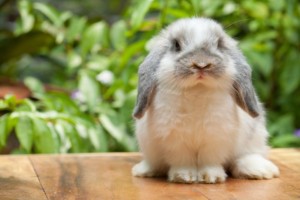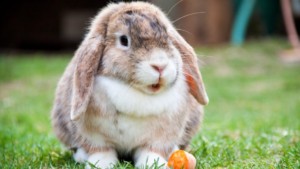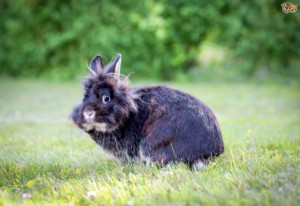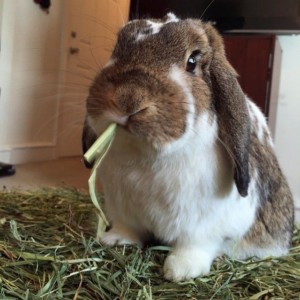Welcome to our Third Edition of our Small Animal Highlight Series: Rabbits! As a quick disclaimer: there are SO many breeds of domestic rabbits out there so this will be a general overview of Rabbit care! If you decide to adopt a Rabbit, please inquire with your vet about specific care for the breed of rabbit you’re adopting.
So, I think most of you are familiar with rabbits: they’re fluffy and cute with little cotton ball tails and giant floppy ears! Rabbits are a fantastic “starter pet” for someone who is interested in bringing a fuzzy friend into their homes but aren’t quite ready for the commitment of a dog or cat. Just like many other types of pets, they are all individuals and their personalities range from wonderfully social to aloof and standoffish. But never fear, there is a Rabbit out there for everyone, and it is important to find a Rabbit with a personality who fits your home and lifestyle. Additionally, like many other animals, Rabbits are a product of their environment. Socially-inclined Rabbits were likely socialized with people from a young age and are comfortable being handled and cuddled. More standoffish Rabbits were likely not handled as young buns and are uncomfortable to an extent with human interaction. However, with patience and love, most Rabbits will come to look forward to human interaction (especially if it is paired with food!).
What should my Rabbit eat?
That’s a great question! Rabbits are herbivores and need a balanced diet to stay healthy and happy. Because rabbits can be so fluffy, they often look a lot bigger than they are, and people wrongly assume they need a lot more food than they actually do! Firstly, you should purchase Rabbit Pellets from a pet store – these are specially designed to deliver appropriate Rabbit nutrients and ensure they get the vitamins and minerals they need in their diet. They should only have about ¼ cup per day, but this can vary depending on the size of the rabbit so please check with your vet before you settle on a daily amount. HAY! Rabbits should have fresh, daily supplies of low-dust hay. This is so important for their digestive tracts and for keeping their ever-growing teeth at the proper length (about 80-90% of a rabbit’s diet should be hay!). Dark, leafy green veggies! Light colored lettuce like iceburg is frankly useless to a rabbit. It is almost 100% water and offers little to no nutrients. On the other hand, veggies like romaine, dandelion greens, kale, collards, turnip and mustard greens, parsley, cilantro and basil are wonderful for rabbits to snack on at least once a day. They can also have limited amounts of sweet veggies (like carrots) and fruit treats (apple slices, banana, sunflower seeds, dried fruits), but it is important to understand that these are TREATS and should not comprise an entire meal. Too much of this type of high-sugar food can throw off their natural bacterial content and lead to unhealthy weight gain. Of course, Rabbits also need constant access to fresh water, either in a heavy bowl as not to tip over, or an appropriate water bottle attached to their cage.
Where should my Rabbit live?
Another super important question! All domestic Rabbits should be housed indoors to protect them from predators, the elements, and parasites. Additionally, while most shelters spay/neuter their rabbits, it’s important to have your Rabbit sexed by a professional and if you have more than 1 rabbit, they should be separated by gender if not spayed/neutered. Otherwise, you’ll learn that the phrase “reproducing like bunnies” is not a joke! There are a variety of Rabbit cages/hutches available for purchase at pet stores or online. You can have free-roaming Rabbits or put them in a small area enclosed by an X-Pen. The preference is yours! There are a few really important factors to keep in mind however. Your rabbit’s habitat should be relative to their size, so make sure that they have enough space to hop around, stretch their legs, and explore. An “average” sized rabbit should have an enclosure that is about 3-4 feet long. Many rabbits are able to be litter trained, and if you adopt them from a shelter, you’ll have a pretty good idea if they already have the concept of a litter box down! You should provide your rabbit with a litter pan low enough for them to hop in and out of, and line it with shredded or pelleted newspaper product, or Carefresh (or a similar product). Low-dust litters are key, and you should not be using clumping cat litter at all! To help your Rabbit use their litter box, put a handful or two of hay inside their box, as they tend to eat and poo simultaneously. Their enclosure should have a hidey box/spot for them so they can escape if they feel threatened – a great option for this is an upside-down cardboard box with a hole cut out of the side. This way, they can hide on it, stand on top of it, and also chew the cardboard! They should have access to their food and water always, along with Rabbit-appropriate toys for mental enrichment. Their enclosure should be in a quiet place that is room-temperature.
What is some typical Rabbit Behavior?
First and foremost, it’s important to understand that Rabbits are prey animals. They do best when their environment is stable and secure, and they have some modicum of control. Therefore, they enjoy arranging their environments the way they like it. Generally, if you see them flipping their boxes, or bunching up towels, it’s because they like it that way! They appreciate having plain cardboard like paper-towel rolls and non-toxic wooden toys to manipulate and play with! They can also get territorial over their environment, and may nip or “box” if they feel their environment is being invaded. It is important to approach them from the side so they can see you coming, and talk to them softly as to not surprise them on approach. Most rabbits really enjoy being pet and rubbed between the ears/eyes, and that is a great way to distract them while you clean their habitat. Be aware that not all rabbits like to be picked up and held, so get to know your rabbit before you attempt a snuggle session! You can also pair human handling with food to get these fluffers used to being handled.
Moral of the story: Rabbits make wonderful pets! They come in a variety of shapes and sizes and personalities so do your research before you take a rabbit into your home. Be aware of the personality you are looking for, and make sure you find the right match for your household. When you find the right fit, you’ll have an amazing companion for years to come!









